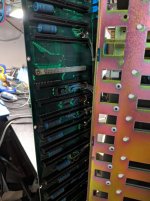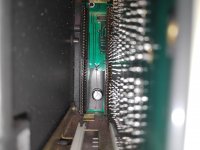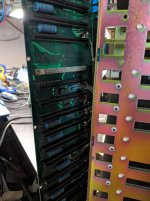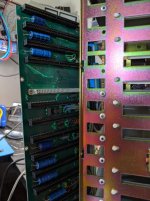It depends of the tape, but with the same tape, the Studer produces noticeable flatter reels compared to the Revox. The A/B77 and PR99 use a technique that was technical standard with the first magnetophon from AEG. That was in 1940's. AEG used the same simple spring loaded mechanical feeler that Revox did. It was a cheap method of loading the tape with constant pressure for flat head contact and fast winding. It never worked successfull in producing perfect fast wound reels. With a Studer, this load becomes dynamic. Its even possible to create an "archive wind" with special load on the tape.
Last edited:
The A810 does amazingly flat winds in both FF and RWD. The tape wind speeds can be changed on the fly. My two Otari MX-50 cannot do anything comparable.
So Wiseoldtech - how did you screw up the adjustments on your 1500? Maybe I can help you.
The Studers, later 5050's and the 1500's attempt constant tape tension, at least across the headblock, and this helps with better tape"packing"
Charles
The Studers, later 5050's and the 1500's attempt constant tape tension, at least across the headblock, and this helps with better tape"packing"
Charles
Huh?
What are you talking about?
Show me where I ever stated that "screwed up" any adjustments.
You need to go back and carefully read any of my previous posts.
What are you talking about?
Show me where I ever stated that "screwed up" any adjustments.
You need to go back and carefully read any of my previous posts.
He was referring to Otari and Technics models. (the comma is the clue here)
I don't know much at all about the Technics deck, but I have a lot of experience with the MX-5050, MX-50 and rather less with the MX-55 - none of these decks have means for measuring and controlling tape tension, any control such as it is relates to the amount of design torque for each mode. Tension is managed basically by the tape pushing against spring loaded tensioners in the MX-5050 and MX-50, the MX-55 has pneumatic dampers. The MX-50 and MX-55 are however substantially gentler than the MX-5050 in my experience.
The only Studer I am at all familiar with is the A810 (I own one) and it has a sophisticated tape tension control system with two transducers to measure the tension which can be changed by entering specific keystrokes on the front panel. (I think these can be reprogrammed if desired)
I don't know much at all about the Technics deck, but I have a lot of experience with the MX-5050, MX-50 and rather less with the MX-55 - none of these decks have means for measuring and controlling tape tension, any control such as it is relates to the amount of design torque for each mode. Tension is managed basically by the tape pushing against spring loaded tensioners in the MX-5050 and MX-50, the MX-55 has pneumatic dampers. The MX-50 and MX-55 are however substantially gentler than the MX-5050 in my experience.
The only Studer I am at all familiar with is the A810 (I own one) and it has a sophisticated tape tension control system with two transducers to measure the tension which can be changed by entering specific keystrokes on the front panel. (I think these can be reprogrammed if desired)
Having managed to find a spare base PCB for my Studer (the backside board where the cards fit into), but it has a different parts number.
Does this means that it wouldn't fit anymore to my deck? Wanted to change something.
Does this means that it wouldn't fit anymore to my deck? Wanted to change something.
I'd look for a later service manual online and see if it is listed as an improved/later card cage/back plane for the A810. Hopefully it is just a bolt in.
I am so inexperienced with Studer gear that's the best I can suggest, short of taking the machine apart and checking it against the original back plane PCB.
I am so inexperienced with Studer gear that's the best I can suggest, short of taking the machine apart and checking it against the original back plane PCB.
Caps on that board were changed to radial ones and I don't like that, because it was done in a non professional way and I like my machine to be in original condition with original parts.
Boards changed in 1984, my original one is 1983 version. There are minor changes in parts, so the boards aren't interchangeable I think.
Have to change motor and PSU caps first, they aren't bad but one is Frako and its good to have a completely new recapped deck. And spooling is too slow.
Boards changed in 1984, my original one is 1983 version. There are minor changes in parts, so the boards aren't interchangeable I think.
Have to change motor and PSU caps first, they aren't bad but one is Frako and its good to have a completely new recapped deck. And spooling is too slow.
Last edited:
If the radials bother you change them out to axial. For recapping first do the transport cards as there are RIFA and Frakos on the spooling and capstan boards. There are a couple on the stabilizer board also. If you are looking to keep everything original looking Kemet makes original style motor and PS filter caps that are stud mounted. Not cheap though. Get the transport working perfectly then move on to the audio cards.
In fact yank them all out while working on the transport.
In fact yank them all out while working on the transport.
Thankfully, through all my years in the repair shop, I never had an issue with customers insisting on a specific style of capacitor replacement.
They just wanted their equipment serviced, reliable, and working like new.
Besides, these components, being on the inside, are never in view anyway, at least in "normal" operation.
They just wanted their equipment serviced, reliable, and working like new.
Besides, these components, being on the inside, are never in view anyway, at least in "normal" operation.
This deck has a recap already and I paid substantial money for that.
I knew that someone will tell that its totally uninterestingly how something has been repaired, but to that I have my own thinking.
Will change those to axials like its stated in the manual.
I knew that someone will tell that its totally uninterestingly how something has been repaired, but to that I have my own thinking.
Will change those to axials like its stated in the manual.
Attachments
Last edited:
That's one reason I provide before and after pictures when I do things. Some people care, some don't even look at them. I personally find it more of a PITA to use an radial and bringing a wire around the can than using like for like. Though axial are getting more difficult to fins and more expensive.
Several thousand for a recap? Send them all my way 🙂
Several thousand for a recap? Send them all my way 🙂
Attachments
Yes, the machine did cost some heavily amount of money. Studers are so sought after and rare today. Love it.
And thats what it should look like, exactly.
I learned a lot with this overhaul. Next A810 I'll do completely by DIY. But the machine is much more complex compared to my B77. And we get rid of the timecode as well, complete new heads, fully aligned. This isn't trivial for a novice. So many things that have to be adjusted the right way.
Next time I'll swap boards until it will function again.
Its slow in windings now. Thats why I changed the rest of the caps, too.
And thats what it should look like, exactly.
I learned a lot with this overhaul. Next A810 I'll do completely by DIY. But the machine is much more complex compared to my B77. And we get rid of the timecode as well, complete new heads, fully aligned. This isn't trivial for a novice. So many things that have to be adjusted the right way.
Next time I'll swap boards until it will function again.
Its slow in windings now. Thats why I changed the rest of the caps, too.
Last edited:
For the slow spooling I would say replace all the caps on the spooling board first but that's been done. Now you need to go through all the tensioner adjustments on both side, both the mechanical and electronic ones. Do it by the book, step by step. Don't be temped to just tweak the pots on the periphery controller.
The pots don't have brought the results I wanted so something other might be wrong.
A real Tentelometer is a bit pricey those days or you have to have your lucky day once in a lifetime.
A real Tentelometer is a bit pricey those days or you have to have your lucky day once in a lifetime.
Last edited:
If you didn't do the electrical adjustments first, messing with the pots will make it worse. See section 3.4 in the manual. Make sure you have 0V in the neutral position and 4V at max deflection. Do this on both the left and right sensor board.
If things are way out of if you move the pots on the periphery controller a bunch you may have to run through it a couple of times.
Were all 7 caps on the spooling board replaced?
If things are way out of if you move the pots on the periphery controller a bunch you may have to run through it a couple of times.
Were all 7 caps on the spooling board replaced?
This deck has a recap already and I paid substantial money for that.
I knew that someone will tell that its totally uninterestingly how something has been repaired, but to that I have my own thinking.
Will change those to axials like its stated in the manual.
As a fellow Studer owner who also paid a substantial premium for fully a serviced A810 I am 100% in agreement. We're not talking a garden variety Teac or Otari here.
I would consider that an amateurish repair at best.
I may use a radial in a pinch temporarily for diagnostic purposes, but would later replace with the right part.
Good axial capacitors are still available from Vishay and a few others - long term I suspect we are headed towards troubled waters.. LOL
Jsantoro has provided a tremendous amount of useful information in the past few posts. - Thank you!
I'm fortunate as my A810 is actually running pretty well.
Schmitz77 I seem to recall that you can program non default speed values for the spooling motors if you want. I am not sure if your MCU is running the default setup or something someone has programmed into as it should be. If it experienced a battery failure it will have forgotten the programmed settings and defaulted to the factory default settings - and then maybe someone reprogrammed it incorrectly.
I'm fortunate as my A810 is actually running pretty well.
Schmitz77 I seem to recall that you can program non default speed values for the spooling motors if you want. I am not sure if your MCU is running the default setup or something someone has programmed into as it should be. If it experienced a battery failure it will have forgotten the programmed settings and defaulted to the factory default settings - and then maybe someone reprogrammed it incorrectly.
- Home
- Source & Line
- Analogue Source
- Which Reel to Reel Fares Best?



